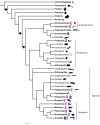Broad Phylogenetic Occurrence of the Oxygen-Binding Hemerythrins in Bilaterians
- PMID: 29016798
- PMCID: PMC5629950
- DOI: 10.1093/gbe/evx181
Broad Phylogenetic Occurrence of the Oxygen-Binding Hemerythrins in Bilaterians
Abstract
Animal tissues need to be properly oxygenated for carrying out catabolic respiration and, as such, natural selection has presumably favored special molecules that can reversibly bind and transport oxygen. Hemoglobins, hemocyanins, and hemerythrins (Hrs) fulfill this role, with Hrs being the least studied. Knowledge of oxygen-binding proteins is crucial for understanding animal physiology. Hr genes are present in the three domains of life, Archaea, Bacteria, and Eukaryota; however, within Animalia, Hrs has been reported only in marine species in six phyla (Annelida, Brachiopoda, Priapulida, Bryozoa, Cnidaria, and Arthropoda). Given this observed Hr distribution, whether all metazoan Hrs share a common origin is circumspect. We investigated Hr diversity and evolution in metazoans, by employing in silico approaches to survey for Hrs from of 120 metazoan transcriptomes and genomes. We found 58 candidate Hr genes actively transcribed in 36 species distributed in 11 animal phyla, with new records in Echinodermata, Hemichordata, Mollusca, Nemertea, Phoronida, and Platyhelminthes. Moreover, we found that "Hrs" reported from Cnidaria and Arthropoda were not consistent with that of other metazoan Hrs. Contrary to previous suggestions that Hr genes were absent in deuterostomes, we find Hr genes present in deuterostomes and were likely present in early bilaterians, but not in nonbilaterian animal lineages. As expected, the Hr gene tree did not mirror metazoan phylogeny, suggesting that Hrs evolutionary history was complex and besides the oxygen carrying capacity, the drivers of Hr evolution may also consist of secondary functional specializations of the proteins, like immunological functions.
Keywords: evolutionay history; metazoa; oxygen-binding protein; transcriptome.
© The Author(s) 2017. Published by Oxford University Press on behalf of the Society for Molecular Biology and Evolution.
Figures




Similar articles
-
Newly Discovered Occurrences and Gene Tree of the Extracellular Globins and Linker Chains from the Giant Hexagonal Bilayer Hemoglobin in Metazoans.Genome Biol Evol. 2019 Mar 1;11(3):597-612. doi: 10.1093/gbe/evz012. Genome Biol Evol. 2019. PMID: 30668717 Free PMC article.
-
Discovery and evolution of novel hemerythrin genes in annelid worms.BMC Evol Biol. 2017 Mar 23;17(1):85. doi: 10.1186/s12862-017-0933-z. BMC Evol Biol. 2017. PMID: 28330441 Free PMC article.
-
A broad genomic survey reveals multiple origins and frequent losses in the evolution of respiratory hemerythrins and hemocyanins.Genome Biol Evol. 2013;5(7):1435-42. doi: 10.1093/gbe/evt102. Genome Biol Evol. 2013. PMID: 23843190 Free PMC article.
-
Recent Insights into the Diversity and Evolution of Invertebrate Hemerythrins and Extracellular Globins.Subcell Biochem. 2020;94:251-273. doi: 10.1007/978-3-030-41769-7_10. Subcell Biochem. 2020. PMID: 32189303 Review.
-
Diversity and distribution of hemerythrin-like proteins in prokaryotes.FEMS Microbiol Lett. 2008 Feb;279(2):131-45. doi: 10.1111/j.1574-6968.2007.01011.x. Epub 2007 Dec 12. FEMS Microbiol Lett. 2008. PMID: 18081840 Review.
Cited by
-
Examining the role of oxygen-binding proteins on the early evolution of multicellularity.bioRxiv [Preprint]. 2023 Dec 4:2023.12.01.569647. doi: 10.1101/2023.12.01.569647. bioRxiv. 2023. PMID: 38106219 Free PMC article. Preprint.
-
Aquatic Invertebrate Antimicrobial Peptides in the Fight Against Aquaculture Pathogens.Microorganisms. 2025 Jan 14;13(1):156. doi: 10.3390/microorganisms13010156. Microorganisms. 2025. PMID: 39858924 Free PMC article. Review.
-
Oxygen-binding proteins aid oxygen diffusion to enhance fitness of a yeast model of multicellularity.PLoS Biol. 2025 Jan 30;23(1):e3002975. doi: 10.1371/journal.pbio.3002975. eCollection 2025 Jan. PLoS Biol. 2025. PMID: 39883703 Free PMC article.
-
TIAMMAt: Leveraging Biodiversity to Revise Protein Domain Models, Evidence from Innate Immunity.Mol Biol Evol. 2021 Dec 9;38(12):5806-5818. doi: 10.1093/molbev/msab258. Mol Biol Evol. 2021. PMID: 34459919 Free PMC article.
References
-
- Altschul SF, Gish W, Miller W, Myers EW, Lipman DJ.. 1990. Basic local alignment search tool. J Mol Biol. 215(3): 403–410. - PubMed
-
- Baert JL, Britel M, Sautière P, Malécha J.. 1992. Ovohemerythrin, a major 14-kDa yolk protein distinct from vitellogenin in leech. Eur J Biochem. 209(2): 563–569. - PubMed
-
- Brown CT, Howe A, Zhang Q, Pyrkosz AB, Brom TH.. 2012. A reference-free algorithm for computational normalization of shotgun sequencing data. arXiv:1203.4802
Publication types
MeSH terms
Substances
LinkOut - more resources
Full Text Sources
Other Literature Sources
Research Materials

